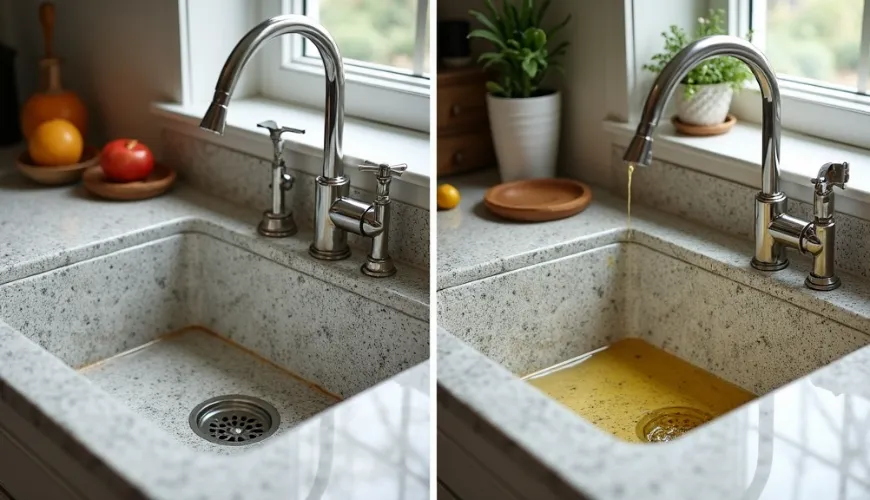
How to Clean a Stained Granite Sink and Keep It Looking New

How to Properly Clean a Granite Sink? Practical Tips for a Sparkling Kitchen
Granite sinks have become a popular choice in modern kitchens. Their matte surface, natural appearance, and scratch resistance make them both a practical and aesthetic addition to any home. However, even these durable materials are susceptible to dirt — especially when it comes to limescale, coffee and tea stains, or a dull surface. Thus, sooner or later, we ask ourselves questions like “how to clean a granite sink?” or “what helps restore a dull black sink to look like new?”. The answers aren't complicated but require the right approach.
Why Does a Granite Sink Need Special Care?
Granite sinks aren't made of pure natural stone, as one might think. Most models are a mixture of granite dust and resin, which gives them strength but also a certain porosity. This feature causes dirt or minerals from the water to settle on the surface — especially in cities with hard water. The combination of daily use and limescale can gradually dull, dry out, and cause the sink to lose its original color.
Particularly black granite sinks can be prone to white limescale stains, while white sinks can easily retain pigments from food or cleaning agents. Fortunately, there are simple and gentle methods to get rid of these issues.
How to Clean a Granite Sink from Limescale?
The most common question with granite sinks is how to get rid of the white film that forms due to hard water. This usually appears after a longer period when the sink is only rinsed and not regularly wiped.
The best way to clean a granite sink from limescale is to use ordinary vinegar. Mix vinegar with water in a 1:1 ratio and apply it to the surface with a cloth or sponge. Let it sit for a few minutes, but not too long — especially with light sinks, where the acid could affect the color. After rinsing, dry thoroughly with a dry cloth. If this procedure is repeated regularly, limescale doesn't stand a chance.
For larger deposits, you can also use baking soda. First, apply soda to the sink, then gently spray with vinegar. The mixture will start to fizz and help release mineral layers. After a few minutes, wipe and rinse with warm water.
How to Clean a Dull Granite Sink and Restore Its Shine?
A dull granite sink not only loses color but also appears "tired." The surface is matte, spotted, and looks dirty even after rinsing. In this case, a somewhat thorough approach is needed.
After removing limescale with vinegar and soda, you can proceed to the restoration step using oil. Yes, ordinary sunflower or olive oil can revive the appearance of granite. Just a few drops on a soft cloth, which you then wipe over the entire sink. The oil will soak into the pores of the material and restore its color intensity and natural shine. This "trick" is especially popular with black and dark sinks, where stains and limescale cause the surface to gray.
An example from an ordinary household? Mrs. Alena from Olomouc had a black granite sink that looked gray after two years of use. She tried a mixture of soda and vinegar, then coated the sink with olive oil, and the result was immediate. "The sink looked like new," she says.
How to Clean a White Granite Sink Without Damage?
With light, especially white sinks, extra caution is needed. Vinegar or lemon juice can leave stains if left on too long. Here, it is recommended to opt for gentler strength — mix baking soda with a little water into a paste and gently rub the stained areas. Avoid rough sponges or brushes that could scratch the surface.
For pigment stains, such as from tea or beetroot, you can try a mixture of hydrogen peroxide and baking soda. However, make sure it's not an aggressive solution, and test it first on an inconspicuous area. Always rinse and dry the sink after cleaning — this applies to all types of granite. Residues of cleaning agents can soak into the surface and leave marks.
How to Care for a Granite Sink Every Day?
Regular maintenance is key to keeping the sink looking new:
- After washing dishes, wipe the sink dry — this prevents limescale formation.
- Once a week, wipe the sink with a damp cloth and a bit of detergent.
- Avoid using aggressive chemicals like bleach or whitening agents.
- Do not use steel wool or rough brushes.
- Oiling once a month helps maintain color and shine, especially for dark sinks.
By maintaining these simple habits, many problems that would otherwise require complex cleaning can be avoided. And as the famous saying goes: "Cleanliness is half the health, but a shiny sink is entire joy."
Interestingly, some brands of granite sinks also offer their own care kits — containing a gentle cleaner, impregnating oil, and a cloth. While their use is not necessary, it can be a convenient solution for those who do not want to improvise with home remedies.
In the end, it must be said that a granite sink does not deserve to be an overlooked workhorse of the kitchen. With a little care and the right approach, it can be the centerpiece of a modern home – beautiful, clean, and durable. Whether it's white, black, or gray, with regular care, it will remain a decoration in your kitchen for many years.

